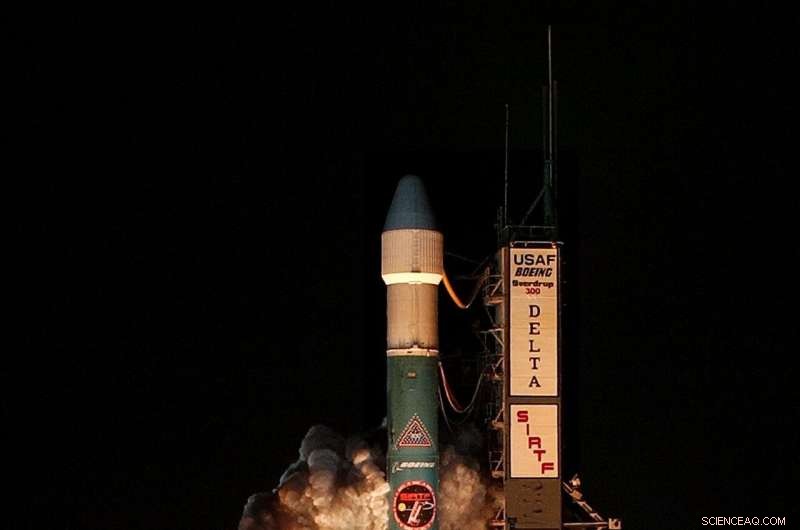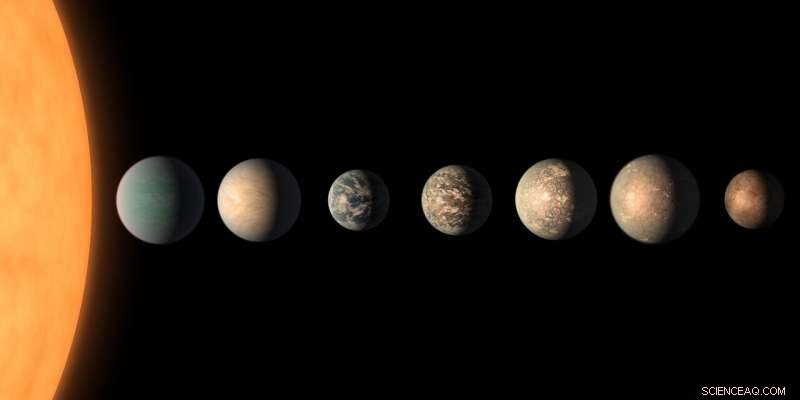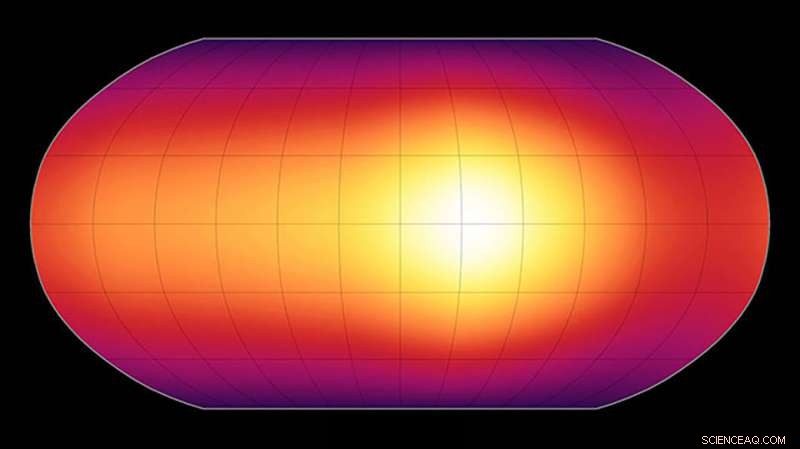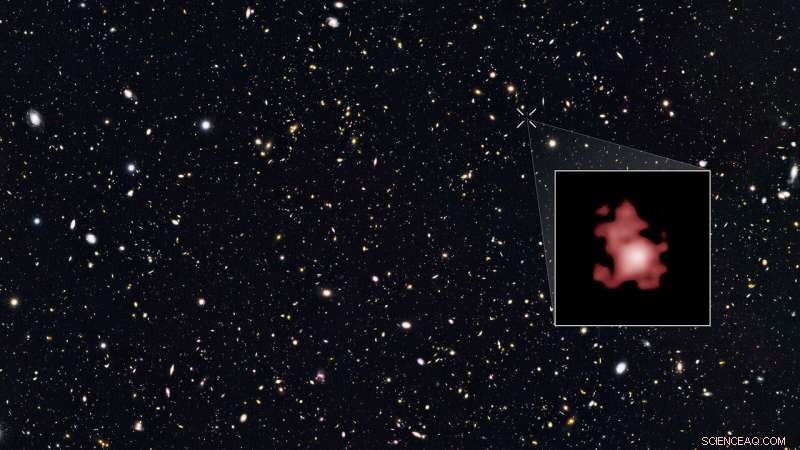 p Telescópio Espacial Spitzer da NASA, então conhecido como Space Infrared Telescope Facility, é lançado da Estação da Força Aérea de Cabo Canaveral, na Flórida, na segunda-feira, 25 de agosto, 2003. Crédito:NASA
p Telescópio Espacial Spitzer da NASA, então conhecido como Space Infrared Telescope Facility, é lançado da Estação da Força Aérea de Cabo Canaveral, na Flórida, na segunda-feira, 25 de agosto, 2003. Crédito:NASA
p Quando uma janela para o universo se fecha, outro será aberto com uma visão ainda melhor. Alguns dos mesmos planetas, as estrelas e galáxias que vimos pela primeira vez através da primeira janela aparecerão com detalhes ainda mais nítidos na janela que logo se abrirá. p O Telescópio Espacial Spitzer da NASA conclui sua missão em 30 de janeiro, 2020, após mais de 16 anos extraordinários de exploração. O telescópio fez muitas descobertas além da imaginação de seus designers, como planetas fora do nosso sistema solar, chamados exoplanetas, e galáxias que se formaram perto do início do universo. Muitos dos avanços do Spitzer serão estudados mais precisamente com o futuro Telescópio Espacial James Webb, com lançamento previsto para 2021.
p "Temos muitas perguntas novas a fazer sobre o universo por causa do Spitzer, "disse Michael Werner, Cientista do projeto Spitzer baseado no Laboratório de Propulsão a Jato da NASA em Pasadena, Califórnia. "É muito gratificante saber que existe um conjunto tão poderoso de recursos surgindo para acompanhar o que pudemos iniciar com o Spitzer."
p Tanto o Webb quanto o Spitzer são especializados em luz infravermelha, que é invisível aos olhos humanos. Mas com seu espelho gigante de berílio revestido de ouro e nove novas tecnologias, Webb tem cerca de 1, 000 vezes mais poderoso. O próximo telescópio será capaz de levar as descobertas científicas de Spitzer a novas fronteiras, desde a identificação de substâncias químicas em atmosferas de exoplanetas até a localização de algumas das primeiras galáxias que se formaram após o Big Bang.
p Além de suas descobertas, O Spitzer também é um pioneiro para Webb em termos de como operar um telescópio desse tipo. Para medir a luz infravermelha com alta sensibilidade, um telescópio deve estar muito frio. O Spitzer mostrou aos engenheiros como um observatório infravermelho se comporta na vastidão do espaço e quais temperaturas os planejadores de missões devem esperar para enfrentar Webb.
p “Ter um telescópio enorme no espaço é difícil. Mas ter um telescópio enorme que é frio é muito mais difícil, "disse Amber Straughn, cientista de projeto adjunto da James Webb Space Telescope Science Communications. "O Spitzer nos ajudou a aprender como operar melhor um telescópio muito frio no espaço."
p Com mais de 8, 700 artigos científicos publicados com base nas descobertas de Spitzer, o telescópio tem sido um tremendo recurso para os astrônomos em uma variedade de disciplinas. Muitos desses resultados tentadores estão prontos para revisitar com um telescópio mais poderoso, e Webb está pronto para começar a investigá-los no início de sua missão. Aqui está uma amostra das realizações de Spitzer nas quais Webb se baseará.
 p O conceito deste artista mostra como pode ser o sistema planetário TRAPPIST-1, com base nos dados disponíveis sobre os diâmetros dos planetas, massas e distâncias da estrela hospedeira. O Telescópio Espacial Spitzer confirmou a presença de dois planetas do tamanho da Terra no sistema antes de descobrir outros cinco. Crédito:NASA / JPL-Caltech
p O conceito deste artista mostra como pode ser o sistema planetário TRAPPIST-1, com base nos dados disponíveis sobre os diâmetros dos planetas, massas e distâncias da estrela hospedeira. O Telescópio Espacial Spitzer confirmou a presença de dois planetas do tamanho da Terra no sistema antes de descobrir outros cinco. Crédito:NASA / JPL-Caltech
p
Exoplanetas
p Uma das descobertas mais impressionantes de Spitzer foi que não existem apenas três, mas sete planetas rochosos do tamanho da Terra orbitando um pequeno, estrela fraca chamada TRAPPIST-1. TRAPPIST-1 é um dos sistemas planetários mais bem estudados além do nosso, mas há muito mais para aprender sobre isso.
p O quarto planeta da estrela, TRAPPIST-1e é especialmente interessante porque tem densidade e gravidade superficial muito semelhantes às da Terra e recebe radiação estelar o suficiente para ter temperaturas amigáveis o suficiente para água em estado líquido. Webb observará este planeta para ter uma noção melhor se o planeta tem uma atmosfera e, se então, qual é a sua química.
p A presença de moléculas como dióxido de carbono, dominante em Marte e Vênus, teria implicações sobre se um planeta poderia ter água líquida e outras condições habitáveis. Webb será capaz de detectar água atmosférica, também. Adicionalmente, Webb irá procurar calor proveniente de TRAPPIST-1b, o planeta mais próximo de sua estrela.
p "A diversidade de atmosferas em torno dos mundos terrestres está provavelmente além de nossa imaginação, "disse Nikole Lewis, professor assistente de astronomia na Cornell University em Ithaca, Nova york. "Obter qualquer informação sobre o ar nesses planetas será muito útil."
p WASP-18b é outro planeta intrigante que Spitzer examinou e que Webb investigará em observações no início da missão. Este gigante gasoso, com 10 vezes a massa de Júpiter, está localizado extremamente perto de sua estrela, completando uma órbita uma vez a cada 23 horas. Por causa de sua alta temperatura - um gritante 4, 800 graus Fahrenheit (2, 650 graus Celsius) —e tamanho grande, é conhecido como "Júpiter quente". Using data from Spitzer and Hubble, astronomers figured out in 2017 that this planet has a lot of carbon monoxide in its upper atmosphere and little water vapor. This planet is particularly interesting because it's so close to its star that it's in danger of being torn apart completely, and it may not survive another million years. Astronomers are interested in using Webb to look at the processes happening in this planet's atmosphere, which will provide insights into hot Jupiters in general.
p Spitzer has also delivered unprecedented weather reports for exoplanets. Em 2007, it made the first-ever map of the surface of an exoplanet, the hot Jupiter HD 189733b, showing its temperature variations and cloud tops. Mais recentemente, in 2016, Spitzer highlighted the climate patterns of 55 Cancri e, a possibly lava-covered world more than twice the size of Earth. But maps from Spitzer have given scientists a lot to think about as they look to further investigations with Webb.
 p This is the first-ever map of the surface of an exoplanet, or a planet beyond our solar system. The map, which shows temperature variations across the cloudy tops of a gas giant called HD 189733b, is made from infrared data taken by NASA's Spitzer Space Telescope. Credit:NASA/JPL-Caltech/Harvard-Smithsonian CfA
p This is the first-ever map of the surface of an exoplanet, or a planet beyond our solar system. The map, which shows temperature variations across the cloudy tops of a gas giant called HD 189733b, is made from infrared data taken by NASA's Spitzer Space Telescope. Credit:NASA/JPL-Caltech/Harvard-Smithsonian CfA
p
Other Exotic Objects
p Spitzer has also made strides in identifying and characterizing brown dwarfs. A brown dwarf is larger than a planet but less massive than a star, and while stars generate their own energy by fusing hydrogen, brown dwarfs do not. Spitzer has been able to look at the clouds in brown dwarf atmospheres and observe how they move and change shape with time. Webb will also examine brown dwarf cloud properties and delve deeper into the physics of these mysterious objects.
p Infrared light has also been revolutionary for looking at disks of gas and dust orbiting stars, and both Spitzer and Webb are sensitive to the infrared glow of this material. Disks that Spitzer has studied contain the raw materials for making planets and may represent the state of our solar system before Earth and its neighbors formed. Spitzer has seen particles around young stars beginning to transform into the seeds of small planetary bodies, and that some disks have materials similar to those seen in comets in our solar system. Webb can look at the same disks and find out even more about the planetary formation process.
p
Oodles of Galaxies
p As light travels from distant objects to Earth, its wavelength becomes longer because the universe is expanding and those objects are moving farther from us. Just like the sound of a siren seems to lower in pitch as an ambulance drives away, light from distant galaxies also lowers in frequency, a phenomenon called "redshift." That means stars that give off visible light in the early universe will appear in the infrared by the time their light reaches Earth. This makes infrared light an especially powerful tool for exploring the universe's ancient past.
p Pinpointing hundreds of billions of galaxies is currently impossible, but Spitzer has made large galaxy catalogs that represent different slices of the universe, containing some of the most distant galaxies we know. The large survey areas of Spitzer and Hubble Space Telescope have allowed astronomers to efficiently look for objects that could be studied in further detail with Webb.
p Por exemplo, Spitzer, together with Hubble, took an image of a galaxy called GN-z11, which holds the record for most distant galaxy measured yet. It is a relic from when the universe was only 400 million years old, just 3% of its current age and less than 10% of its size today.
 p This is the first-ever map of the surface of an exoplanet, or a planet beyond our solar system. The map, which shows temperature variations across the cloudy tops of a gas giant called HD 189733b, is made from infrared data taken by NASA's Spitzer Space Telescope. Credit:NASA/JPL-Caltech/Harvard-Smithsonian CfA
p This is the first-ever map of the surface of an exoplanet, or a planet beyond our solar system. The map, which shows temperature variations across the cloudy tops of a gas giant called HD 189733b, is made from infrared data taken by NASA's Spitzer Space Telescope. Credit:NASA/JPL-Caltech/Harvard-Smithsonian CfA
p "Spitzer surveyed thousands of galaxies, mapped the Milky Way and performed other groundbreaking feats by looking at large areas of the sky, " said Sean Carey, manager of the Spitzer Science Center at Caltech/IPAC in Pasadena, Califórnia. "Webb won't have this capability, but it will revisit some of the most interesting targets in the Spitzer surveys to reveal them in amazing clarity."
p O que mais, Webb's higher sensitivity will allow the telescope to look for galaxies dating back even earlier in the universe. And questions still abound about these distant galaxies:Are there a lot of stars forming in them or relatively few? Are they rich in gas or poor? Are there black holes at their centers, and how do those black holes interact with stars? E, scientists have pondered a chicken-and-egg problem for decades about which came first:the black hole or the surrounding galaxy?
p "We'll be able to see some of the earliest galaxies to form in the universe that we've never seen before, " said Straughn.
p Closer to home, Spitzer also studied many examples of a mysterious kind of galaxy called a luminous infrared galaxy, or LIRG. Such galaxies are generating tens to hundreds of times more energy per second than a typical galaxy, and most of that energy takes the form of far-infrared light. Scientists have used Spitzer to study LIRGs and learn about star formation and the growth of black holes during periods of rapid evolution when galaxies collide and merge. Such collisions were even more common 6 billion to 10 billion years ago and influenced the evolution of the universe as we know it.
p "Webb will take inspiration from Spitzer and examine a variety of nearby and distant LIRGs to learn more about the role of galactic mergers, bursts of star formation and the growth of supermassive black holes in galactic evolution over cosmic time, " said Lee Armus of Caltech, who will lead a LIRG observing program for Webb.
p
Into the Infrared Unknown
p For more than 16 years, Spitzer mapped out many of the most pressing questions in infrared astronomy. Now it's up to Webb to revisit them with sharper vision, through the grandest window yet to the cosmos.



